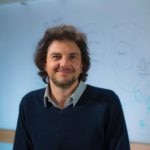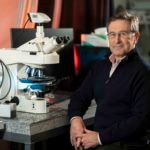Frontiers of Knowledge Award for those who discovered the mechanism that regulates cellular growth
The BBVA Foundation presented Michael Hall and David Sabatini the Frontiers of Knowledge Award in the Biology and Biomedicine category for discovering the main regulator of growth in animal cells. This mechanism, a molecular pathway called mTOR, opens the door to new treatment options for cancer, diabetes and aging.

Hall and Sabatini’s research is already having significant clinical implications. The pharmaceutical that acts on this molecular target, rapamycin, is used for a wide range of pathologies, including cancer, diabetes and degenerative diseases associated with aging, such as Alzheimer’s and Parkinson’s.This pioneering work also offers clues to help shed light on why controlled fasting or calorie restriction fosters longevity - a phenomenon observed in numerous species since last century, and demonstrated in mice in the last decade.
“The function of the mTOR protein is to control cellular growth. In simple terms, mTOR is what makes us grow when we eat,” Michael Hall explained after receiving the news of the award. “Cellular growth is important not only after the fertilization of an egg, giving rise to a full organism, but also in other contexts, such as muscles getting bigger after exercise,” he added.
The Professor of Biochemistry at the University of Basel’s Biozentrum Center for Molecular Life Sciences in Switzerland continued his explanation, adding that: “Any situation where there is cell growth is controlled by mTOR in response to the availability of nutrients, also in disease contexts like cancer, where cells that are not supposed to grow are growing.”
David Sabatini was more graphic, comparing the mechanism with a switch: “mTOR is a switch that turns on in the presence of nutrients, so the body can build material [grow], and when there are no nutrients available it breaks the material down,” explained the Professor of Biology at the Massachusetts Institute of Technology (MIT).

David Sabatini, BBVA Foundation Frontiers of Knowledge Award - BBVA Foundation
Hall’s research on yeast in 1991 and Sabatini’s research on mammals’ cells in 1994 were carried out independently, but can be considered complementary. Sabatini has said that he “never could have imagined” the implications of his first discovery, which took place when he was still a PhD student. With his thesis, he sought to contribute to understanding of the therapeutic applications of rapamycin. After isolating the molecule in yeast and mice, both researchers began exploring its multiple functions in organisms.
The fight against cancer and longevity
“mTOR has a central role in the cell, so central that when it doesn’t work properly it can lead to many different diseases. Cancer is an obvious one because it is a disease of inappropriate cell growth,” Hall explained. And although the anti-cancer properties of rapamycin were already known, “it has been developed as an anti-cancer drug and is used in the clinic.” Rapamycin is now used as an immunosuppressant to prevent rejection of transplanted organs, as an anti-cancer agent and in cardiovascular diseases. “It is rare that a drug is used in three major therapeutic areas, but that just underscores the central role of mTOR,” he continued.

Michael Hall, BBVA Foundation Frontiers of Knowledge Award - BBVA Foundation
Meanwhile, Sabatini indicated that “up to 60% of cancers have some mechanism for turning on the mTOR pathway.” He also mentioned its role in neurological disorders like epilepsy, and neurological diseases associated with aging. “There is evidence that inhibition of the mTOR pathway could also ameliorate the symptoms of conditions like Alzheimer’s or Parkinson’s.”
The relationship between the mTOR pathway and the prevention or slowing of aging is currently one of the most active areas of research in this field. Sabatini is optimistic, but warned: “We need to do a lot more research, but I think there is a good chance we may be able to exploit this pathway to combat aging-related diseases. I don’t know if it will help us live to be 120, but I think it will have beneficial effects on different physiological systems. And I am practically sure that it will ameliorate aspects of aging-related diseases.”